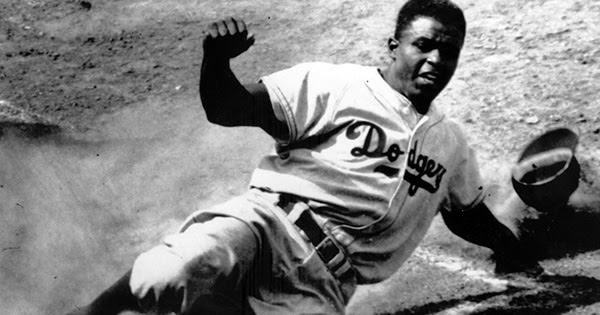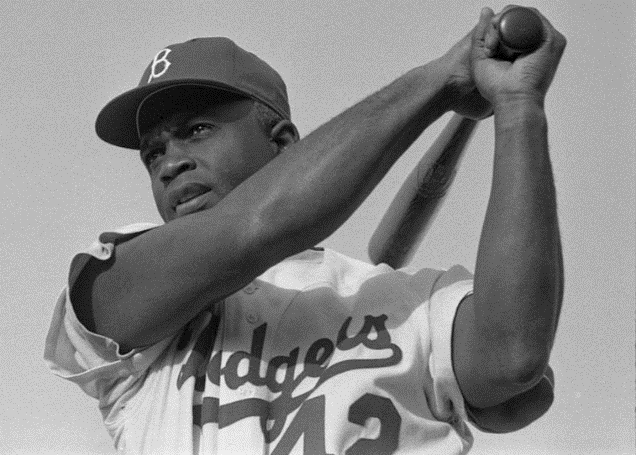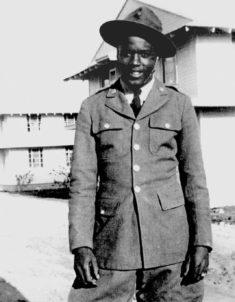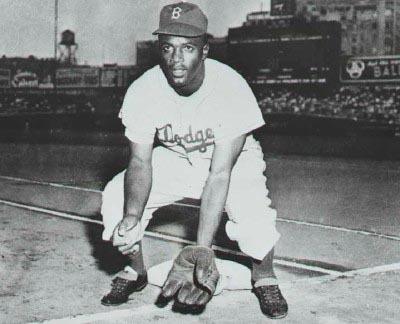Jackie Robinson
He was an American professional baseball player who became the first African American to play in Major League Baseball (MLB) in the modern era.
1919
1972
Cairo, Georgia, USA
African American
1947 – Robinson was the second most popular man in the country
In 1999 – Robinson was named by Time on its list of the 100 most influential people of the 20th century.
1999 – he ranked number 44 on the Sporting News list of Baseball’s 100 Greatest Players and was elected to the Major League Baseball All-Century Team as the top vote-getter among second basemen.
Baseball writer Bill James, in The New Bill James Historical Baseball Abstract, ranked Robinson as the 32nd greatest player of all time strictly on the basis of his performance on the field, noting that he was one of the top players in the league throughout his career.
1984 – Robinson was among the 25 charter members of UCLA’s Athletics Hall of Fame in 1984.
2002 – Molefi Kete Asante included Robinson on his list of 100 Greatest African Americans
1982, 1999, 2000 – Robinson has also been honoured by the United States Postal Service on three separate postage stamps.
The City of Pasadena has recognised Robinson with a baseball diamond and stadium named Jackie Robinson Field in Brookside Park next to the Rose Bowl, and with the Jackie Robinson Centre (a community outreach centre providing health services).
1997 – a bronze sculpture by artists Ralph Helmick, Stu Schecter, and John Outterbridge depicting nine-foot busts of Robinson and his brother Mack was erected across from the main entrance of Pasadena City Hall.
After Muir, Robinson attended Pasadena Junior College (PJC), where he continued his athletic career by participating in basketball, football, baseball, and track. On the football team, he played quarterback and safety. He was a shortstop and leadoff hitter for the baseball team, and he broke an American junior college broad-jump record held by his brother Mack with a jump of 25 ft. 61⁄2 in. on 7 May 1938. As at Muir High School, most of Jackie’s teammates were white. While playing football at PJC, Robinson suffered a fractured ankle, complications from which would eventually delay his deployment status while in the military. In 1938, he was elected to the All-Southland Junior College Team for baseball and selected as the region’s Most Valuable Player.
That year, Robinson was one of 10 students named to the school’s Order of the Mast and Dagger (Omicron Mu Delta), awarded to students performing “outstanding service to the school and whose scholastic and citizenship record is worthy of recognition.” Also while at PJC, he was elected to the Lancers, a student-run police organisation responsible for patrolling various school activities.
An incident at PJC illustrated Robinson’s impatience with authority figures he perceived as racist, a character trait that would resurface repeatedly in his life. On 25 January 1938, he was arrested after disputing the detention of a Black friend by police. Robinson received a two year suspended sentence, but the incident—along with other rumoured run-ins between Robinson and police—gave Robinson a reputation for combativeness in the face of racial antagonism. While at PJC, he was motivated by a preacher (the Rev Karl Downs) to attend church on a regular basis, and Downs became a confidante for Robinson, a Christian. Toward the end of his PJC tenure, Frank Robinson,to whom Robinson felt closest among his three brothers,) was killed in a motorcycle accident. The event motivated Jackie to pursue his athletic career at the nearby University of California, Los Angeles (UCLA), where he could remain closer to Frank’s family.
Robinson’s major league debut brought an end to approximately sixty years of segregation in professional baseball, known as the baseball colour line. After World War II, several other forces were also leading the country toward increased equality for Blacks, including their accelerated migration to the North, where their political clout grew, and President Harry Truman’s desegregation of the military in 1948. Robinson’s breaking of the baseball colour line and his professional success symbolized these broader changes and demonstrated that the fight for equality was more than simply a political matter. Civil rights movement leader Martin Luther King Jr said that he was “a legend and a symbol in his own time”, and that he “challenged the dark skies of intolerance and frustration.” According to historian Doris Kearns Goodwin, Robinson’s ”efforts were a monumental step in the Civil Rights revolution in America … [His] accomplishments allowed Black and white Americans to be more respectful and open to one another and more appreciative of everyone’s abilities.”
Beginning his major league career at the relatively advanced age of 28, he played only ten seasons from 1947 to 1956, all of them for the Brooklyn Dodgers. During his career, the Dodgers played in six World Series, and Robinson himself played in six All-Star Games. In 1999, he was posthumously named to the Major League Baseball All-Century Team.
Robinson’s career is generally considered to mark the beginning of the post–`long ball’ era in baseball, in which a reliance on raw power-hitting gave way to balanced offensive strategies that used foot speed to create runs through aggressive base running. Robinson exhibited the combination of hitting ability and speed which exemplified the new era. He scored more than 100 runs in six of his ten seasons (averaging more than 110 runs from 1947 to 1953), had a .311 career batting average, a .409 career on-base percentage, a .474 slugging percentage, and substantially more walks than strikeouts (740 to 291). Robinson was one of only two players during the span of 1947–56 to accumulate at least 125 steals while registering a slugging percentage over .425 (Minnie Miñoso was the other).[ He accumulated 197 stolen bases in total, including 19 steals of home. None of the latter were double steals (in which a player stealing home is assisted by a player stealing another base at the same time). Robinson has been referred to by author David Falkner as “the father of modern base-stealing”.
Parents – Mallie and Jerry Robinson
Siblings – Edgar, Frank, Matthew, Willa Mae
Wife – Rachel Robinson
Children – Jackie Robinson Jr, Sharon Robinson and David Robinson
https://www.Blackhistory.com/2018/07/how-jackie-robinson-became-first-african-american-player-pro-basketball.html
https://www.kidzworld.com/article/3081-sports-moments-in-Black-history/
Jackie Robinson: The Trailblazer for Black Athletes in Professional Sports
https://en.wikipedia.org/wiki/Jackie_Robinson
https://www.sportingnews.com/us/mlb/news/Black-history-month-jackie-robinson-pro-basketball/lcotd1hmheinkranc9edrbxh





